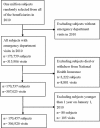Prevalence of and Predictors for Frequent Utilization of Emergency Department: A Population-Based Study
- PMID: 26200638
- PMCID: PMC4603019
- DOI: 10.1097/MD.0000000000001205
Prevalence of and Predictors for Frequent Utilization of Emergency Department: A Population-Based Study
Abstract
Frequent emergency department (ED) users contribute to a disproportionate number of ED visits that consume a substantial amount of medical resources. Additionally, people with frequent ED visits may be at greater risks of illnesses and injury and are vulnerable to even more severe health events. We conducted, based on a nationally representative sample, a population-based study to estimate the prevalence of frequent ED users among all ED users, and to explore factors associated with frequent ED visits. This is a population-based cross-sectional study. Data of 1 million people randomly selected from all beneficiaries of Taiwan's National Health Insurance claim database in 2010 were analyzed to estimate the distribution of ED visit among ED users. Multivariate logistic regression was employed to calculate the independent associations of factors with prevalence of frequent (4-12 ED visits per year) and highly frequent (>12 ED visits per year) ED visits. Of the 1 million beneficiaries 170,475 subjects used ED service in 2010 and 103,111 (60.5%), 37,964 (22.3%), 14,881 (8.7%), 14,041 (8.2%), and 460 (0.3%) subjects had 1, 2, 3, 4 to 12, and more than 12 ED visits, respectively. ED users with 4 to 12 visits and those with >12 visits disproportionally accounted for 24.1% and 3.0%, respectively, of all ED visits in 2010. We noted significant associations of frequent ED visit with a number of factors including socio-demographics, health care utilization, and comorbidity. Among them, the most increased adjusted odds ratio (AOR) was noted for hospitalization during the past year (AOR = 1.85) and younger ages (1-6 years) (AOR = 1.84). On the contrary, the significant predictors for highly frequent ED visit with greater AOR included hospitalization during the past year (AOR = 3.95), > 12 outpatient visits during the past year (AOR = 2.66), and a history of congestive heart failure (AOR = 2.64) and psychiatric disorders (AOR = 2.35). People admitted and with frequent outpatient visits were at greater risk of frequent ED visit. Because people with a history of various comorbidities were also vulnerable to become frequent ED users, careful management of those comorbidities by clinicians may help further reduce the likelihood of frequent ED visit.
Conflict of interest statement
The authors have no conflicts of interest to disclose.
Figures
References
-
- Lowthian JA, Curtis AJ, Cameron PA, et al. Systematic review of trends in emergency department attendances: an Australian perspective. Emerg Med J 2011; 28:373–377. - PubMed
-
- Goodell S, DeLia D, Cantor JC. Emergency Department Utilization and Capacity. 2009, Robert Wood Johnson Foundation Policy Brief No. 17. Princeton, NJ: Robert Wood Johnson Foundation; http://www.rwjf.org/content/dam/farm/reports/issue_briefs/2009/rwjf43566 [Accessed May 7, 2014].
-
- Forero R, Hillman KM, McCarthy S, et al. Access block and ED overcrowding. Emerg Med Australas 2010; 22:119–135. - PubMed
-
- Derlet RW. Overcrowding in emergency departments: increased demand and decreased capacity. Ann Emerg Med 2002; 39:430–432. - PubMed
Publication types
MeSH terms
LinkOut - more resources
Full Text Sources
Miscellaneous



